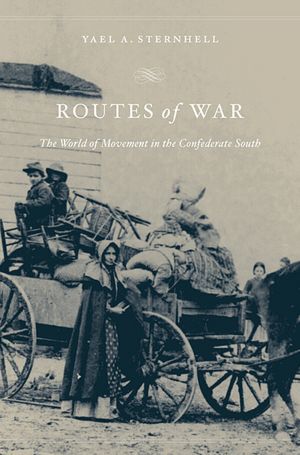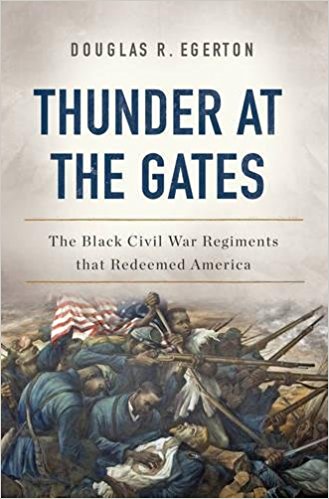Routes of War: The World of Movement in the Confederate South by Yael A. Sternhell. Harvard University Press, 2012. Cloth, ISBN: 0674064423. $49.95.
 Some changes in historical interpretation are driven by uncovering new sources. Others come as a consequence of new methods or new analytical interests. Still others derive more simply, from scholars shifting their gaze and looking at old problems and familiar sources in new ways. Yael Sternhell’s new book adopts this latter strategy. She evaluates the eastern theater of war (mostly Virginia) through the years of war and into the opening moments of Reconstruction, territory familiar to most students of the Civil War. The novelty in her approach is to consider the entire population – soldiers, civilians, blacks, whites, men, women, Confederates, Unionists, loyalists and deserters – and their experiences from the perspective of motion.
Some changes in historical interpretation are driven by uncovering new sources. Others come as a consequence of new methods or new analytical interests. Still others derive more simply, from scholars shifting their gaze and looking at old problems and familiar sources in new ways. Yael Sternhell’s new book adopts this latter strategy. She evaluates the eastern theater of war (mostly Virginia) through the years of war and into the opening moments of Reconstruction, territory familiar to most students of the Civil War. The novelty in her approach is to consider the entire population – soldiers, civilians, blacks, whites, men, women, Confederates, Unionists, loyalists and deserters – and their experiences from the perspective of motion.
This shift enables her to produce several important insights into the nature of the war. Sternhell’s analysis helps us see not just the connections between the home front and the battlefront but the fact that these spaces exist on a short continuum of shared experience. This argument represents the final stage in the leveling of soldier and civilian experience that has been developing in the literature for the last several decades. Sternhell observes that the movement of volunteers from Deep South states to Richmond in mid-1861 helped reconstitute an intra-regional harmony weakened in preceding decades by the rise of Cotton South fire-eaters as leaders of the region. According to Sternhell, this movement in effect built the nation. Her argument here dovetails with other recent work showing the physical nature of Confederate nationalism as opposed to the ideological content that preoccupied past scholars. But Sternhell smartly shows how the flow of soldiers through the South also held the potential to turn against the Confederacy, as happened in 1862 and beyond, when the tramp of dirty, sick, ill-clothed, and often ill-behaved men through southern communities depressed civilian morale and cast doubt on the viability of the larger national project.
Carrying the story into 1863, Sternhell offers a sharp historiographical intervention. In contrast to scholars such as Steven Hahn and Stephanie McCurry who have urged us to see the Civil War as a slave rebellion, Sternhell asserts that “American slaves did not rise in rebellion against their masters” (93). Her emphasis on slave movement – which destroyed slavery as effectively as violence might have – shifts our perspective on what emancipation meant. Drawing attention to the lack of violence committed against masters, Sternhell emphasizes slaves’ desire to control their own bodies and their movement. They left for a freedom that consisted of the right to be secure with their families wherever they wanted. Sternhell’s narrative pairs the increasing traffic of escaping slaves on southern roads with the white movement that paralleled it at the same time. Sick soldiers escaping hospitals, stragglers falling by the wayside, deserters lighting out for the country, and white women refugeeing with or without their slaves filled southern byways alongside black freedom-seekers. These people resembled fleeing slaves in many ways – they were disorganized, confused about direction, and fearful of what awaited them. But in other respects, as Sternhell notes, these populations experienced very different movement. Black freedom was on the rise, symbolized by their ability to move. White freedom, in contrast, seemed on the wane. The Confederate army pursued deserters, the Confederate government imposed a pass system for civilian travel on the railroads, and social conservatives (a category that included most southern whites) worried about the ramifications on families and communities of so much movement. The cumulative effect of Sternhell’s narrative shows us a chaotic Confederate South, but one that broke down at the social rather than political level.
Sternhell’s book gathers a host of eloquent testimony on the nature of people’s movement during the Civil War. The narrative is cogent and well written and many readers will find her analytical approach refreshing. But as with any other sort of historiographical shift, we must ask how a new perspective changes our understanding of the war. Does focusing on movement alter how we explain why people took the actions they did? Does it alter the meaning of those actions? The answers to these questions are not always apparent. As this review suggests, Sternhell’s approach produces a number of important observations, but the book also contains unstated implications that merit greater elaboration. The contingent nature of Confederate nationalism presented here – dependent upon the pomp and circumstance of mobilization and the physical presence of a national army – suggests the fragility of the southern effort but northerners shared much the same experience. Does the movement-centered vitality of nationalism inhere only in insurgent powers or do incumbent powers depend upon it as well? Does the physical presence of deserters and stragglers nullify whatever ideological content such actions might have had? Most importantly for the future, can states hope to control movement during war? Sternhell’s emphasis on mobility presents the coagulation and disintegration of the Confederacy as something like an organic process, suggesting a deep consistency in human action across wars and places – that movement (like change) defines the human experience. My call for answers to these questions reflects both Sternhell’s effectiveness as a guide to the action of the war and to the multiple, often conflicting ways in which people moved about within it and to her success at widening our vision of what the Civil War meant.
Aaron Sheehan-Dean is the Eberly Professor of Civil War Studies at the University of West Virginia and the author of Why Confederates Fought (2009).
